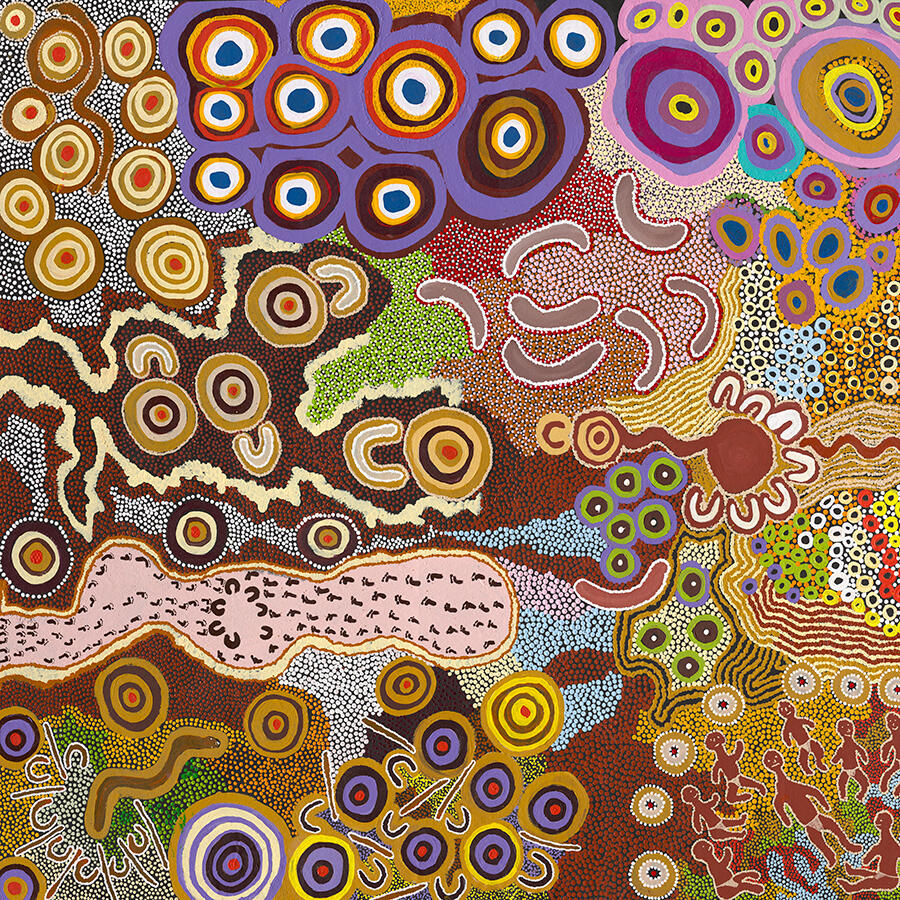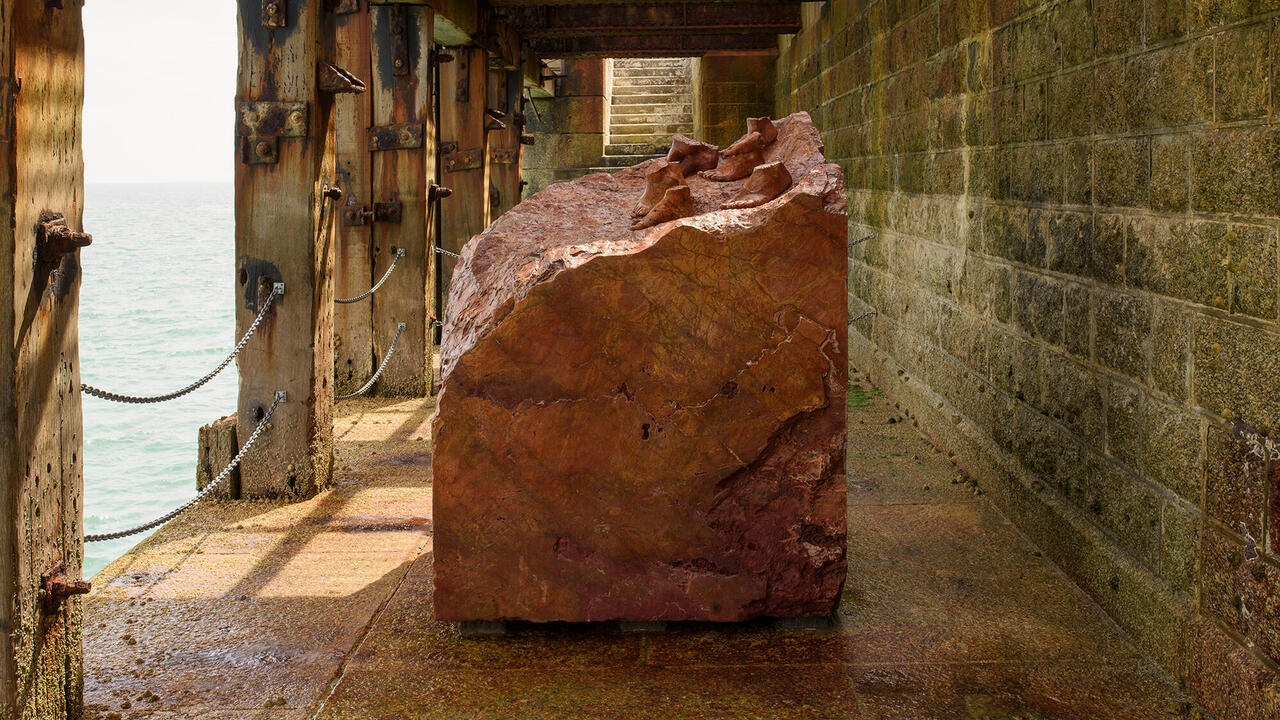Stories From Indigenous Australia
At The Box, Plymouth, the paradigm-shifting show presents more than 300 paintings, sculptures, ceramics, weavings and films in blazing celebration of the profoundly rich culture
At The Box, Plymouth, the paradigm-shifting show presents more than 300 paintings, sculptures, ceramics, weavings and films in blazing celebration of the profoundly rich culture

Since the beginning of human history, people have looked to the night sky for guidance and solace. The origin story of the nearest star cluster to Earth, the Pleiades, is mentioned in Homer’s Odyssey and the Bible, and also features in Aztec, Chinese, Japanese, Māori and Persian cultures, to mention just a few. For Indigenous Australians, the Pleiades are seven sisters who transformed themselves into stars to escape a lecherous magician, Wati Nyiru, who left his footprint on Orion. The story is told in song, painting and performance via songlines or dreamings, a mnemonic system that, in tracing the journeys of Ancestral spirits, conveys crucial information about survival on this vast continent. As well as tracing the journeys of ancestral spirits, the songlines map long-established routes across the land from one territory to the next; they’re a crucial body of both cultural and practical knowledge known as ‘Tjukurpa’ that helps people survive in an unforgiving continent. Communicating many things – from the location of waterholes and the identification of medicinal plants to the ethics of kinship, marriage rules and codes of general behaviour – the stories of a particular songline must be communicated in a way that holds the attention of the listener, so that each generation will remember and reproduce them. Aboriginal culture is oral: if the songline is lost, then so is collective memory and meaning.

Kungkarrangkalpa Tjukurrpa, 2015. Courtesy: © the artists/Copyright Agency 2020 and National Museum of Australia
In 2010, Margo Neale, Head of the Indigenous Knowledges Curatorial Centre at the National Museum of Australia in Canberra, met with a group of Aṉang elders from the Western Desert. One of them, a man called David Miller, made a heartfelt plea: ‘You mob gotta help us […] those songlines they been all broken up now […] you can help us put them all back together again.’ As the Anangu’s older generation were dying, taking their traditional knowledge with them, the younger generation weren’t returning to ‘Country’ – the site of belonging, information, stories and secrets – to learn their Tjukurpa.
Rising to David Miller’s challenge, over the next seven years, Margo Neale travelled 7,000 kilometres to assemble a ‘curatorium’ of 20 custodial elders from across the Central and Western Deserts of Australia – territory that encompasses the lands of the Martu, Ngaanyatjarra and Anangu Pitjantjatjara Yankunytjatjara (APY) peoples. The result is ‘Songlines: Tracking the Seven Sisters’: an exhibition of more than 300 paintings, sculptures, ceramics, weavings, installations and films made by over 100 artists and collectives.

This thrilling, paradigm-shifting show began its journey at the Museum of Australia in 2017 and has just opened at The Box in Plymouth. (It will later travel to the Humboldt Forum in Berlin and then the Musée du Quai Branly in Paris.) The story of the Seven Sisters was chosen as a focus because, in Neale’s words, it explores
‘[…] tragedy and comedy, obsession and trickery, desire and loss, solidarity and sorrow that touches on life’s moral dimensions: how to live with each other on this earth sustainably; how to care for each other and share resources equitably.’
The project extends beyond the gallery walls. It’s become part of Aṟa Irititja, an online archive (overseen by an Anangu board) that includes research by Indigenous and Western scholars who have documented the Seven Sisters ‘cartographically, archaeologically, ecologically, visually and performatively’.

A sense of both great joy and great pride pervades ‘Songlines’: elders embodied as projections welcome you into their space, which are signposted as if you were moving across the land itself. Questions weave in and out of the different displays: what’s the relevance of ancestral stories to the 21st century? What are songlines and why are they significant? Languages (there are around 250 spoken by First Nation Australians) and objects – such as ceramics, carvings and weavings – shape-shift according to the location that is under the spotlight. Paintings, many of them made collectively by women, might to the uninitiated look like deliriously beautiful dot-and-colour-field abstractions, but are, in fact, highly codified maps of the land and its inhabitants. The monumental Yarrkalpa (Hunting Ground) (2013), for example – one of the most staggering paintings I’ve seen in recent years – was created by artists from the Martumili collective: Kumpaya Girgirba, Yikartu Bumba, Kanu Nancy Taylor, Ngamaru Bidu, Yuwali Janice Nixon, Reena Rogers, Ngarga Thelma Judson and Ngalangka Nola Taylor.
In her essay in the excellent catalogue that accompanies the exhibition, Neale describes these paintings as ‘portals to place’ – objects to be revered, nurtured, touched and shared. They don’t simply describe or represent Country, they are Country: virtuosic repositories of information and connection embodying a culture that has been in existence for 65,000 years – humanity’s oldest and most consistent. The evolution of the Yarrkalpa painting is documented in Lynette Wallworth’s three-channel video installation Always Walking Country: Parnngurr Yarrkalpa (2014), a piece that she made in collaboration with Martu artists, whom we see grouped around a large canvas on the ground, painting, talking and singing.

Indigenous society is adaptable. While traditional skills are honoured, as Curtis Taylor, one of the young filmmakers whose work is included in the show, says: ‘Just like the old people, we are dreaming […] We’re using the newest technology with the oldest culture.’ In a specially designed seven-metre travelling dome, exhibition visitors are virtually transported to the sacred site of Walinynga (also known as Cave Hill) – the only known ancient rock art site to depict the Seven Sisters. Absorbed by traditional owner Stanley Douglas’s narration of the sisters’ story, people lie on their backs looking up at a 360-degree animation in which the sisters dance their way across the cosmic swirls painted on the cave’s interior and a time-lapsed transit of Pleiades and Orion.
In 1768, Captain Cook set sail from Plymouth to Australia, a country that he claimed two years later on behalf of Britain using the legal concept of ‘Terra Nullius’ (‘nobody's land’) – a travesty that opened the doors to colonisation. That ‘Songlines: Tracking the Seven Sisters’ is now on view in Plymouth is a powerful riposte to the crimes of the past – and a blazing celebration of the endurance of a profoundly rich culture.
‘Songlines: Tracking the Seven Sisters’ is at The Box, Plymouth until 27 February 2022.
Main image: Nyangapa Nora Nangapa (Nungabar), Minyipuru (detail), 2008. Courtesy: © the artists/Copyright Agency 2020 and National Museum of Australia























